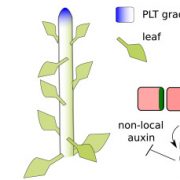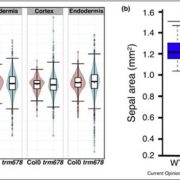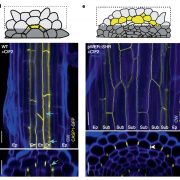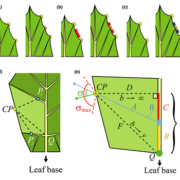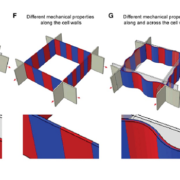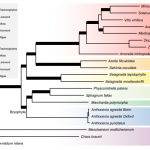Review. Signalling pathways underlying nitrogen-dependent changes in root system architecture: from model to crop species (J. Exp. Bot.)
 Nitrogen (N) is one of the seventeen essential nutrients for a plant to complete its life cycle and is one of the most important determinants of productivity of various crops globally. Nitrate (NO3‑) and ammonium (NH4+) are the major plant-available forms of N. The spatiotemporal heterogeneity of N is tackled by the plastic responses of the plant root system which helps the plant explore for N. Jia and von Wirén have reviewed the signalling pathways underlying the modulation in root system architecture due to internal and external N signals. First the authors discuss the plant root system’s response to availability of N in the soil. When a root comes across a localized N-rich zone, NO3‑ or NH4+ acts as a signalling molecule and stimulates lateral root elongation; branching is stimulated through the transceptor NRT1.1/NFP6.3 or AMT transporters, respectively which is termed as foraging. When a root comes across a homogenous availability of N, the response of the root growth is dose-dependent; a moderate availability promotes the root growth where as a high availability suppresses the same. The authors also discuss the mechanisms underlying root system’s response during N scarcity. Plants stimulate root growth when the scarcity is mild; on the other hand, when the scarcity is severe, plants adopt an economical strategy of survival by halting their root growth and developement. Understanding the underlying genetic factors and mechanisms is essential for enhancing the nutrient use efficiency in economically important crops through various crop improvement programmes using breeding and genome editing. (Summary by Hari Gowthem G) J. Exp. Bot. 10.1093/jxb/eraa033
Nitrogen (N) is one of the seventeen essential nutrients for a plant to complete its life cycle and is one of the most important determinants of productivity of various crops globally. Nitrate (NO3‑) and ammonium (NH4+) are the major plant-available forms of N. The spatiotemporal heterogeneity of N is tackled by the plastic responses of the plant root system which helps the plant explore for N. Jia and von Wirén have reviewed the signalling pathways underlying the modulation in root system architecture due to internal and external N signals. First the authors discuss the plant root system’s response to availability of N in the soil. When a root comes across a localized N-rich zone, NO3‑ or NH4+ acts as a signalling molecule and stimulates lateral root elongation; branching is stimulated through the transceptor NRT1.1/NFP6.3 or AMT transporters, respectively which is termed as foraging. When a root comes across a homogenous availability of N, the response of the root growth is dose-dependent; a moderate availability promotes the root growth where as a high availability suppresses the same. The authors also discuss the mechanisms underlying root system’s response during N scarcity. Plants stimulate root growth when the scarcity is mild; on the other hand, when the scarcity is severe, plants adopt an economical strategy of survival by halting their root growth and developement. Understanding the underlying genetic factors and mechanisms is essential for enhancing the nutrient use efficiency in economically important crops through various crop improvement programmes using breeding and genome editing. (Summary by Hari Gowthem G) J. Exp. Bot. 10.1093/jxb/eraa033
[altmetric doi=”10.1093/jxb/eraa033″ details=”right” float=”right”]


